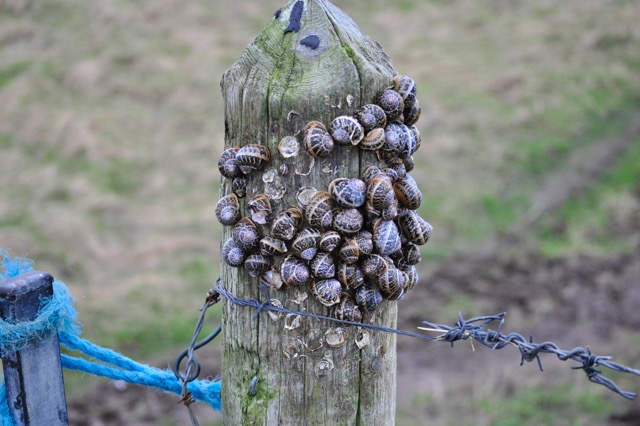CateDevineWriter
Demand for Barra delicacy is growing at a snail's pace - but catch them while you can.
In some ways, they're a match made in heaven.
The browns, greys, yellows and creams and reflected blue hues in their shells seem like a visual echo of their wild Hebridean habitat. And the molluscs inside are as robust and salt-licked as the air around them
Isle of Barra snails grow freely in the grassland and around the sand dunes in the north-east of the island and are easily spotted in clusters on wooden fence posts. When I first encountered them a couple of years ago on holiday with a group of friends, we were taken aback both by their abundance and the picturesque sight they made. Nobody seems to know why they are peculiar to the island - one spurious explanation is that the Romans introduced them, but since the Romans never reached the Outer Hebrides (they only ever wrote about them) that's highly unlikely. I reckon a more plausible explanation is simply that they're a product of the clean, mineral-rich terroir of this unspoiled part of the world.
Like the cockles and the razorclams that crowd the sands of Barra's stunning beaches, the snails are a wonderful source of nutritious, flavoursome seafood that's easy to forage.
The story of their Outer Hebridean provenance makes them unique, and I wouldn't be surprised if they were next on the growing list of Scottish foods to gain Protected Geographical Indicator (PGI) status. They might also become a major food export alongside langoustines, salmon and beef; after all, they are the ultimate symbol of the international Slow Food movement.
Their local, natural deliciousness is the reason the most progressive chefs are crazy for them. I first wrote about Barra snails a couple of years ago, when they started to replace the French gourmet gastropods on Scottish menus. Fred Berkmiller, chef-patron of Edinburgh's - ha - l'Escargot Bleu and l'Escargot Blanc restaurants, was quick to spot the delicious irony of cooking them in "le style francais" - slow-cooked with butter, garlic and parsley - and as a confit in olive oil with star anise and crushed garlic, served on a tomato concasee with sauce verte (salsa verde).
He took delivery of 1000 Barra snails, which he compared to the celebrated (and protected) Petits Gris of France; this year he's taking yet more. Spring is the best time to collect them as they begin to stir from hibernation(continues after illustration...)

Tom Kitchin, chef-patron of the Michelin-starred The Kitchin and gastropub Scran and Scallie in Edinburgh, is also a fan. He first put them on his menu at The Kitchin last year after a successful trial, and says he would like to use them again because of their "slightly salty flavour" and their "amazing Barra story". His dish of snails from the island of Barra, St George mushrooms and roasted bone marrow was praised by one critic, who said they were "salty and earthy and balanced beautifully with bone marrow, girolles and capers". Kitchin has razorclams from Barra on the menu right now; he plans to use the cockles and "langoustes" or crawfish; all perfectly suit his nature-to-plate ethos. The Old Inn at Carbost on Skye, Barley Bree in Crieff and the Sun Inn at Dalkeith have also featured Barra snails.
The snails are collected by hand, cleaned and posted out live by local entrepreneur Gerard MacDonald. He cleans them by starving them for a week so they naturally purge themselves of any impurities - not a difficult task, since they contain no pesticides, weedkillers or other toxins, and don't really need extra treatment. In France, by contrast, snails are fed flowers and carrots to colour them, so the purging process can be monitored. But such intervention is unnecessary on Barra.
MacDonald says he is handling around 100kg a year but could manage up to two tonnes if necessary. He's surprised that there is so little interest from Glasgow chefs, and is considering sending out "taster packs" of two dozen snails with recipe ideas to ignite more interest. Who will be the first to speed up the snail's pace?
At the moment, Barra snails cost around £13 to £20 a kilo - in stark contrast to Norfolk farmed snails, which I understand are going for around £55 per kilo. But when even Noma restaurant in Copenhagen uses indigenous snails out of their shells with potatoes, or as confit set in real flowers, for dishes on its £160 tasting menu, perhaps it's time the wild snails of Barra joined the constellation of star menus. Experimental dishes with Danish snails created in the Nordic Food Lab, also run by chef-patron Rene Redzepi, include a fun Snails and Moss: 32 snails are fed beetroot until they turn red, then boiled alive. Meanwhile, moss is scraped from the side of a fjord and blanched until colourless. Finally, they are reformed to resemble the Danish flag. And why not? Another dish is a broth of clam and leek stem served with sea snails.
It can only be a matter of time until the idea catches on here. I don't mean it as a pun when I say when it comes to foraged wild snails, it's a case of catching them while you can.
- This article was first published in The Herald.
